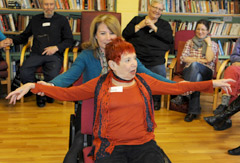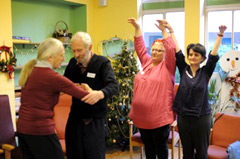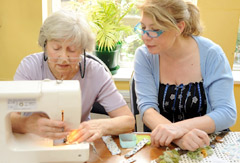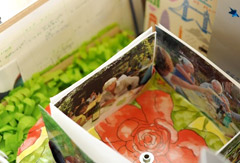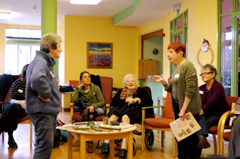Review of RTRT project: UK
London, Camden, in association with Camden Carers
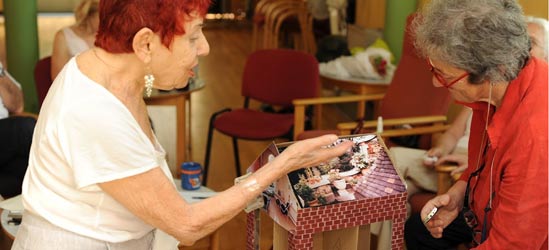
Memorable moments that took place in our RTRT group
-
“It’s just great to have shared positive time together. However challenging it is, I want to continue talking to [my partner] about our pasts using objects, photos, music and so on”
Vera, a carerBridie, a lady in her late 80s whose memory was very impaired, suddenly recalled her enjoyment in being a “lollipop lady”, that is someone who helps schoolchildren to cross busy roads to get to their school, by holding up a big stick with a round top on it (like a lollipop). Two volunteers became (in role) children on the way to school and one ‘became’ a big red London bus, which had to be stopped at the crossing. Bridie talked to them all in their roles, with herself in role as the crossing keeper. She was very delighted with her success and the applause she received
-
Marco, who finds it extremely difficult to stay in the room for more than a few minutes, was attracted by the live accordian music played by a skilled volunteer. The subject of country dancing had cropped up (as two people in the group had a special interest in it) and our musician spontaneously played. Soon almost everyone was dancing a fairly anarchic country dance, and Marco thoroughly enjoyed it, circulating happily and having physical and eye contact with all the dancers
-
“It was so enjoyable reliving forgotten memories. I would love to find some way of continuing this wonderful experience. Other people’s memories triggered off my own. I need to keep in touch more with my old friends to keep my memories alive”
BillyBilly “became” her younger self during a session on working lives. She walked around the room, as though she was responsible for its interior design, making notes and musing about colours, proportions, light, etc. We all experienced her as she must have been, full of authority, and excited by the potential of spaces. She then showed us pictures of a glass table she had designed and rooms she had planned and lived in herself, which her son had brought with to share with us
-
Stanley and Vera agreed to be the wedding couple and we all really felt present at a celebration of their relationship. We all had a part to play, and there was lots of comedy, but an underlying seriouseness. They were the undoubted centre of attention. Vera had initially been somewhat reluctant to commit to the sessions, thinking that Stanley would not enjoy them, but both really participated and became quite central to our group
-
“I think my friends whose memories have in various degrees deteriorated could benefit from such sessions”
StanleySeeing Eileen, a lady in her 80s supported by her daughter, threading up a sewing machine and working on a wall-hanging she had designed with artist/volunteer Sheree, gave us a strong sense of Eileen as a highly competent semstress. Her stitching was based on memories of her schooldays in the country where she was very happy, and all the energy of her youth was re-experienced by her and us, as she recreated it with such skill
The main things we have learned
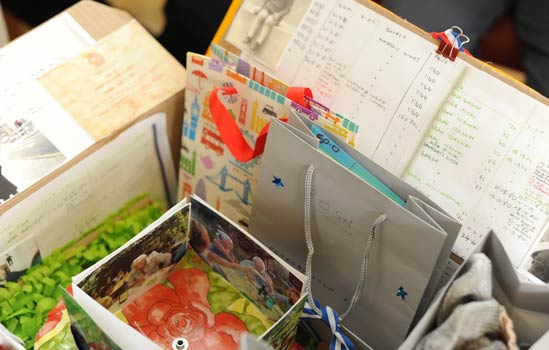
Successes to build on:
-
“It provides a wonderful opportunity to meet a variety of other people with dementia and other carers; A good opportunity to share past experiences together, and to do this in a stimulating, warm, humorous environment; It’s just great to have shared positive time together, which stimulates conversation outside of the session”
Kate, a carerWe had been anxious about doing the project with a largely middle-class group of rather sophisticated couples. We wondered if they would need very different prompts (music, dance, situations) to stimulate memories, and whether they would “let their hair down” in response. We need not have worried. It was easy to reflect their interests and experiences in relation to each topic and there was no sense of class-divide within the group
-
We were reminded of the power of music to create a positive, spontaneous atmosphere, and also to remind people of their younger selves and others who were important to them
-
Taking risks and asking people to do things, even if we thought they might refuse, usually paid off. For example, whenever we got up and invited participants to be part of an enactment they did so with pleasure. This depended on creating an atmosphere of adventure and safety at the same time: a delicate balance, but highly productive of memory and well-being
The main things that the carers in our groups learned about reminiscence
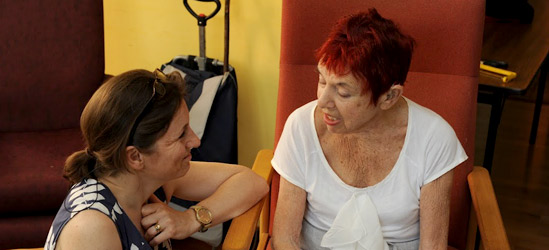
-
That their relative could still share their memories when stimulated, and that they could continue this stimulation at home
-
That the socialising with new people had been successfully achieved and that more contact with others to have a good time was very important
-
That sharing memories about their relationship in the past help support these relationships in the present
What the people with dementia in our groups gained from the project:
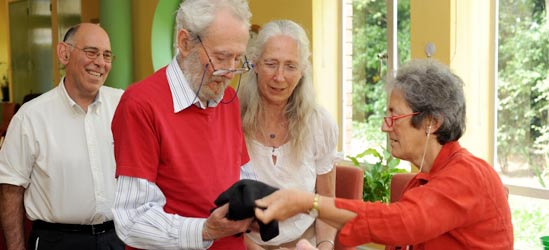
-
New friendships and a welcome possibility to locate and share common past experiences
-
“The meetings have had an extremely beneficial effect on my mother. She looks forward to each meeting and they have brought her a great deal of happy moments recalling events in her life”
David, a carerA lot of fun and laughter
-
Being pleasantly surprised by how much they could remember
Future plans
-
We hope to continue the sessions with backing from local council, health authorities and other support. In any future sessions involving reminiscence in dementia care, we shall attempt to involve artists and the making of reminiscence end products, whether made by the group of by individual families.

